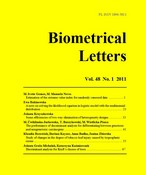
Biometrical Letters vol. 48(1), 2011, pp. 41-54


The aim of the present study was to examine the use of a variety of statistical discriminant functions to the classification of genotoxic and non-genotoxic carcinogens. To this purpose, the data from an experiment conducted by van Delft et al. (2005) were applied. The investigated methods included DQDA, DLDA, boosting trees, bagging trees, bagboosting trees, KNN, and SVM. Two gene selection methods were examined: first using tests based on a linear model (Smyth et al., 2004), with a multiple-testing correction of the resulting p-values, and the second based on the tests applied to re-sampled datasets. The outcomes suggest that, when the discrimination between genotoxic and non-genotoxic carcinogens is of interest, the choice of the discrimination method is essential. The misclassification errors may be also the confirmation of the correctness of gene selection methods.

classification, discriminant analysis, misclassification errors, genotoxicity, carcinogen chemical compounds, microarray data, gene expression data

